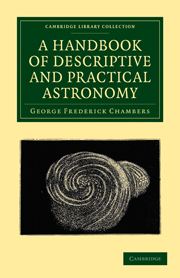Book contents
- Frontmatter
- PREFACE
- SUPPLEMENT
- Contents
- LIST OF ILLUSTRATIONS
- PRINCIPAL AUTHORITIES
- Errata
- A Handbook of Descriptive and Practical Astronomy
- BOOK I A SKETCH OF THE SOLAR SYSTEM
- CHAPTER I THE SUN
- CHAPTER II THE PLANETS
- CHAPTER III VULCAN
- CHAPTER IV MERCURY
- CHAPTER V VENUS
- CHAPTER VI THE EARTH
- CHAPTER VII THE MOON
- CHAPTER VIII MARS
- CHAPTER IX THE MINOR PLANETS
- CHAPTER X JUPITER
- CHAPTER XI SATURN
- CHAPTER XII URANUS
- CHAPTER XIII NEPTUNE
- BOOK II ECLIPSES AND THEIR ASSOCIATED PHENOMENA
- BOOK X METEORIC ASTRONOMY
- APPENDICES
- INDEX TO SUBJECTS
- INDEX TO NAMES
- Plate section
CHAPTER II - THE PLANETS
Published online by Cambridge University Press: 05 July 2011
- Frontmatter
- PREFACE
- SUPPLEMENT
- Contents
- LIST OF ILLUSTRATIONS
- PRINCIPAL AUTHORITIES
- Errata
- A Handbook of Descriptive and Practical Astronomy
- BOOK I A SKETCH OF THE SOLAR SYSTEM
- CHAPTER I THE SUN
- CHAPTER II THE PLANETS
- CHAPTER III VULCAN
- CHAPTER IV MERCURY
- CHAPTER V VENUS
- CHAPTER VI THE EARTH
- CHAPTER VII THE MOON
- CHAPTER VIII MARS
- CHAPTER IX THE MINOR PLANETS
- CHAPTER X JUPITER
- CHAPTER XI SATURN
- CHAPTER XII URANUS
- CHAPTER XIII NEPTUNE
- BOOK II ECLIPSES AND THEIR ASSOCIATED PHENOMENA
- BOOK X METEORIC ASTRONOMY
- APPENDICES
- INDEX TO SUBJECTS
- INDEX TO NAMES
- Plate section
Summary
Around the Sun as a centre, certain bodies, called planets, revolve, at greater or less distances: they may be divided into two groups, (i.) The inferior planets, comprising Vulcan, Mercury, and Venus; and (ii.) the superior planets, including Mars, the Minor Planets, Jupiter, Saturn, Uranus and Neptune, the Earth being the boundary between the two. If viewed from the Sun, all the planets, inferior and superior, would appear to spectators placed on the Sun, to revolve round that luminary in the order of the zodiacal signs; such, however, is not the case when the motions of the planets are watched from one of their number itself in motion; it consequently happens that the apparent motions of the inferior planets on the one hand, and the superior on the other, differ considerably. The former are never seen in those parts of the heavens in opposition to the Sun, but are sometimes to the east and sometimes to the west of it. Twice in every revolution an inferior planet is in conjunction with the Sun (Fig. I); in inferior conjunction, when it comes between the Earth and the Sun, and in superior conjunction when the Sun intervenes between the Earth and the planet. When it attains its greatest distance from the Sun, east or west, it is said to be at its greatest elongation—east or west, as the case may be.
- Type
- Chapter
- Information
- A Handbook of Descriptive and Practical Astronomy , pp. 11 - 27Publisher: Cambridge University PressPrint publication year: 2010First published in: 1861



